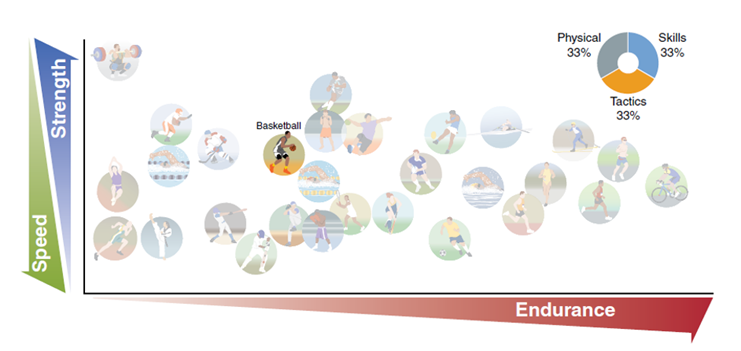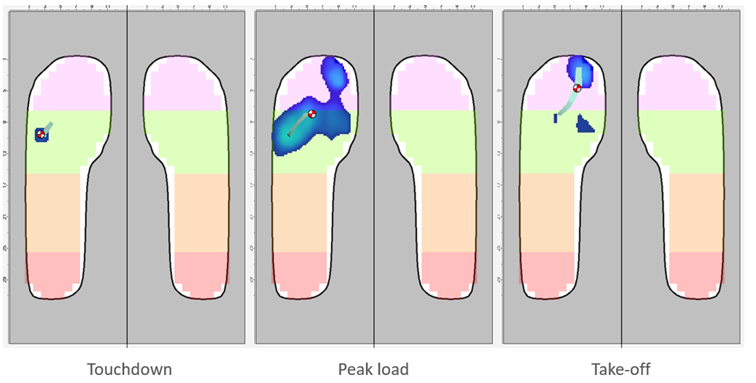
The Use of Plantar Pressure Mapping in Basketball
Basketball is a sport of intermittent high-intensity activities. It is characterized by continuous direction changes, accelerations, decelerations, short sprints, and high-impact movements such as jumping.
High-intensity running and agility represent key performance factors from a biomechanics perspective, and the ability to maintain an efficient movement output repeatedly during the game is paramount.
Plantar pressure mapping technology, like XSENSOR's Intelligent Insoles | Pro, can be used in this context by both performance and medical staff to analyze running biomechanics and foot function during sport-specific skills.
It is worth noting that physical qualities, skills, abilities, and tactical awareness all play an equally important role in basketball players' performance and are balanced in percentage of contribution (Fig. 1).

Figure 1. The position of the basketball player on the three axes illustrates the relative importance of the three main physical capacities of importance for elite participation in basketball (from Laursen and Buchheit "Science and Application of High-Intensity Interval Training, adapted from G.A. Nader, "Concurrent Strength and Endurance Training: From Molecules to Men", Medicine & Science in Sports & Exercise 38, no. 11 (2006): 1965-1970).
The level of physical development and conditioning is going to dictate the proper expression of both tactical and technical skills, and the relative importance of each component of physical qualities (strength, speed, and endurance) is going to vary depending on the position of the player, their characteristics and style of play.
The Demands of a Basketball Player
Proper analysis of the performance model of a specific sport to understand the energy requirements, the muscles involved in a gesture, and the type of actions occurring during a game is essential.
The requirements and demands of a basketball player can be summarized as follows:
- Physiological contributions from both aerobic and anaerobic energy systems
- Alactic contribution at 60%, lactic at 20%, and aerobic at 20%
- Strength and balance capabilities
- Power abilities
- Accelerations and multidirectional abilities
- Decision-making processes
The second step after the identification of the ergogenesis (contribution in the percentage of each energy system), the type of actions, the type of speed, the specific strength, and the specific range of motion involved in basketball performance, is to choose the appropriate tests to target and evaluate the identified particular characteristics.
In the case of basketball performance, by using plantar pressure mapping insoles, we can assess both acceleration and agility capabilities from a biomechanical qualitative and quantitative point of view. Additionally, coaches can decide to assess any sport-specific movements and situations, which gives a higher degree of freedom to evaluate many game components, such as biomechanical behavior and movement efficiency during ball handling, dribbling, shooting performance, and landing after jumping.
Plantar Pressure Mapping Testing in Basketball
Acceleration and the ability to sprint over short distances represent crucial qualities in basketball performance, so the 20 m test is usually used to assess acceleration (over the 5 m and 10 m splits) and sprinting ability over sport-specific distances, as the average sprint distance in basketball is 15 m or sometimes less.

Figure 2. Example of a 20 m acceleration test of a basketball player using XSENSOR's Intelligent Insoles | Pro.
For agility testing in basketball, the goal is to evaluate the ability to perform frequent changes in a direction specific to the game movement patterns, and the basketball agility test involves forward acceleration with four changes in direction (1).
Some key metrics that can be obtained by performing acceleration and agility testing with plantar pressure mapping insoles in basketball players include the distribution of pressure during the whole stance phase, the trajectory of the center of pressure, and the bilateral timing of the foot. Furthermore, these metrics and data can be visualized and isolated by zones (rearfoot, midfoot, forefoot). This allows coaches to identify areas at risk of potential stress fractures due to high pressure and analyze foot function and overall mechanics efficiency.
To learn more about using plantar pressure mapping technology to build a player pressure profile in basketball and how to use the software to analyze the data, watch the third part of the Plantar Pressure Mapping in Team Sports online seminar series, 'How to Profile Basketball Players with XSENSOR's Intelligent Insoles'.
References
- Pyne DB et al., Basketball Players in Physiological Tests for Elite Athletes. 2013. Human Kinetics 2nd ed.
- Laursen and Buchheit, Science and Application of High Intensity Interval Training. 2019. Human Kinetics.
